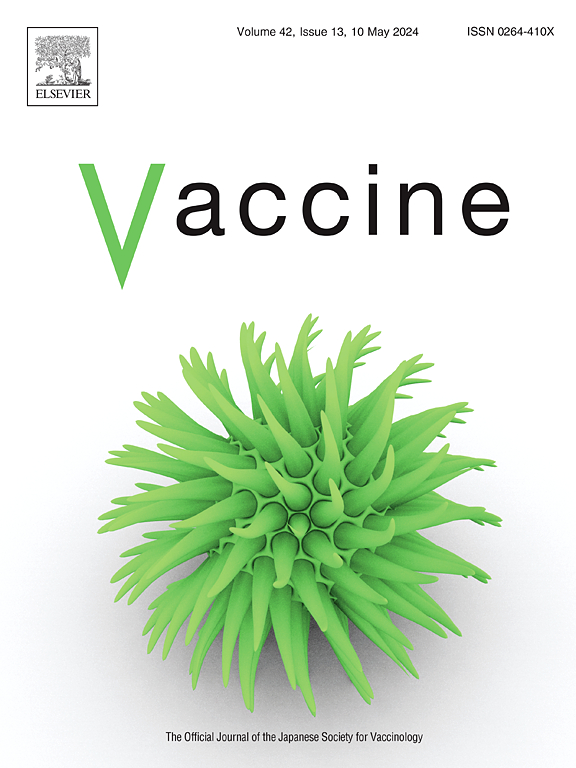Evidence on trends in uptake of childhood vaccines and association with COVID-19 vaccination rates
IF 4.5
3区 医学
Q2 IMMUNOLOGY
引用次数: 0
Abstract
Importance
Childhood vaccination rates have declined in recent years; there is also concern that resistance to COVID-19 vaccines could spill over to childhood vaccines.
Objectives
To use local-level data to study trends in childhood vaccination rates and heterogeneity in local rates; including how many areas are below herd-immunity thresholds, and assess the association between COVID-19 vaccine hesitancy and childhood vaccination.
Design
We report, for 11 states with available data, vaccination rates for measles, mumps, rubella (MMR), and diphtheria, tetanus, acellular pertussis (DTaP) vaccines, including percentage of schools/counties with rates ≥95 %, 90–95 %, 80–90 %, and < 80 %. We also study the association between county-level COVID-19 vaccination rates and change from 2019 to 2022 in MMR and DTaP vaccination rates.
Exposure
School/county level vaccination rates; county-level COVID-19 vaccine hesitancy, proxied by the percent of the adult population in each county that did not complete primary COVID-19 vaccination.
Main outcomes
Percentage of school/counties with MMR/DTaP vaccination rates within specified ranges, mean vaccination rates, and change in MMR/DTaP vaccination rates between 2019 and 2022.
Results
On average, childhood vaccination rates declined from 2019 to 2022 in states that allow non-medical exemptions, but with substantial heterogeneity within and across states. The largest declines were in already low-vaccination schools. COVID-19 vaccine hesitancy was associated with a somewhat larger 2019-to-2022 decline in childhood vaccination rates in rural counties and strongly Republican-leaning counties.
Conclusion
Vaccination rates fell from 2019 to 2022, continuing a longer trend toward lower rates. For measles and pertussis, childhood vaccination rates are below herd-immunity levels in many local communities, sometimes substantially so. We used two proxies for potential spillover of COVID-19 vaccine hesitancy to childhood vaccines (rural indicator and Republican-leaning indicator); these proxies can explain a modest part of the decline childhood vaccination in rural and Republican-leaning counties, but most of the explanation lies elsewhere.
儿童疫苗接种趋势及其与COVID-19疫苗接种率关联的证据。
重要性:近年来儿童疫苗接种率有所下降;人们还担心,对COVID-19疫苗的耐药性可能会蔓延到儿童疫苗。目的:利用地方数据研究儿童疫苗接种率的趋势和地方接种率的异质性;包括有多少地区低于群体免疫阈值,并评估COVID-19疫苗犹豫与儿童接种疫苗之间的关系。设计:我们报告了11个有可用数据的州的麻疹、腮腺炎、风疹(MMR)和白喉、破伤风、无细胞百日咳(DTaP)疫苗的接种率,包括接种率≥95%、90- 95%、80- 90%的学校/县的百分比,以及暴露:学校/县的接种率;县级COVID-19疫苗犹豫,以每个县未完成COVID-19初级疫苗接种的成年人口百分比表示。主要结局:2019年至2022年期间MMR/DTaP疫苗接种率在规定范围内的学校/县百分比、平均接种率以及MMR/DTaP疫苗接种率的变化。结果:平均而言,在允许非医疗豁免的州,儿童疫苗接种率从2019年到2022年有所下降,但在州内和州间存在很大的异质性。下降幅度最大的是疫苗接种率已经很低的学校。2019- 2022年,农村县和强烈倾向共和党的县的儿童疫苗接种率下降幅度较大,这与COVID-19疫苗犹豫有关。结论:疫苗接种率从2019年到2022年下降,持续较长时间的下降趋势。对于麻疹和百日咳,在许多地方社区,儿童疫苗接种率低于群体免疫水平,有时严重低于群体免疫水平。我们使用了两个代理指标来衡量COVID-19疫苗对儿童疫苗的潜在溢出(农村指标和共和党倾向指标);这些代理可以解释农村和共和党倾向县儿童疫苗接种率下降的部分原因,但大部分解释都在其他地方。
本文章由计算机程序翻译,如有差异,请以英文原文为准。
求助全文
约1分钟内获得全文
求助全文
来源期刊

Vaccine
医学-免疫学
CiteScore
8.70
自引率
5.50%
发文量
992
审稿时长
131 days
期刊介绍:
Vaccine is unique in publishing the highest quality science across all disciplines relevant to the field of vaccinology - all original article submissions across basic and clinical research, vaccine manufacturing, history, public policy, behavioral science and ethics, social sciences, safety, and many other related areas are welcomed. The submission categories as given in the Guide for Authors indicate where we receive the most papers. Papers outside these major areas are also welcome and authors are encouraged to contact us with specific questions.
 求助内容:
求助内容: 应助结果提醒方式:
应助结果提醒方式:


